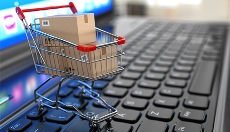
Let’s start things off on an inspirational note: you’ve detected a gap in the marketplace (local, regional, national and/or international), have done some market research and due diligence, and are confident that you can be the solution that customers urgently need — which is good for them, and great for you.
However, before you launch your online store and watch customers beat a virtual path to your door, you need to answer a critical question: what ecommerce fulfilment model will you use: 3PL, self-fulfilment or dropshipping? Here’s a brief rundown of each to give you a sense of what might be on the horizon.
- 3PL
3PL — which stands for third party logistics provider — is a fulfilment model in which inventory (either finished goods that you purchase or items that you manufacture) is shipped to the 3PL’s warehouse. Through an order fulfilment platform, your online store’s inventory is synced with the 3PL. For example, if you have 2341 iPhone cases in stock with the 3PL, then your online store will reflect the same amount. When a customer purchases an item from your online store, the order is automatically passed through to your 3PL for fulfilment, and the inventory number is adjusted accordingly.
Obviously, 3PLs charge for their services. However, the expense can be a smart investment because it enables you to focus on branding, marketing, advertising, promotions, and so on.
- Self-Fulfilment
As the term suggests, self-fulfilment is when you (and/or your team) handles everything on your own. This includes receiving, picking, packing, labeling and shipping orders. While this may seem cheaper than using a 3PL, as noted above keep in mind that it is a manual, time consuming process — and every hour that you spend getting items ready for shipment is an hour you can’t spend on other activities such as acquiring new customers, developing referral partnerships, and so on.
What’s more, since you aren’t a logistics expert, there’s a chance that you’ll make some administrative errors (shipping to the wrong address, shipping the wrong product, shipping the wrong quantity, etc.). These typically lead to returns and customer churn, plus can damage your reputation.
- Dropshipping
Dropshipping is a fulfilment model in which you have no inventory on-hand. When a customer places an order, your dropshipping partner — which could be a retailer, wholesaler, or manufacturer — automatically receives it (through a synced software platform), and fulfils it directly to the customers.
Considering this, you may be asking a good question: why wouldn’t you just use dropshipping instead of 3PL? After all, you don’t have to buy any inventory in advance, and you don’t have to handle any shipping tasks in-house. What’s the catch?
Well, it’s not a catch, but it is indeed a factor: compared to 3PL, profit potential with dropshipping is limited — and in some cases, significantly. Basically, with dropshipping, your profit margin will be the difference between wholesale and retail; which on some products could be a handful of percentage points. What’s more, as this article highlights some states treat dropshippers as revenue cash cows and drill them with additional taxes.
It’s beyond the scope of this (or any other) article to advise you on which ecommerce fulfilment model is right for you. In fact, you may even decide to combine models — using 3PL for certain products or areas, and using dropshipping and/or self-fulfilment for other products. The key takeaway is that it’s definitely in your best interest to do your research now vs. later, so that you can put your online store on-track for sustained success.






